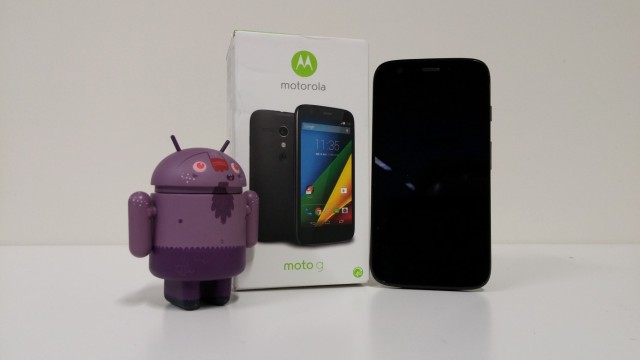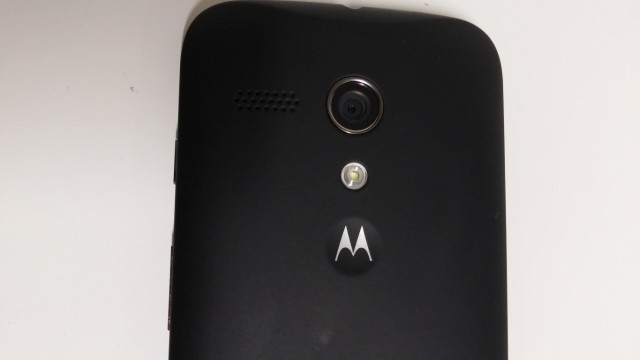
The Google owned Motorola, faced some issues in releasing their first generation of devices. The Motorola Moto X took 8 months to reach our shores, but with the release of the Moto G, it seemed like Motorola found their feet, taking just over 2 months to reach our shores in January this year.
The Moto G has been quite well received both critically, where it’s received praise for its smooth experience, paired with rock bottom price, as well as by the general public where it’s led to Motorola proclaiming it their most successful smartphone to date. But it’s not perfect, there has always been a core audience who’ve derided the phone for its lack of 4G, and with 4G rolling out in more countires, Motorola saw an opportunity to expand their range and so released the Moto G 4G.
The handset went on-sale in Australia in July, where it was pretty well received. We’ve gotten our hands on it, and we’ve decided to give it a mini-review looking at the updated features and 4G speeds.
- Screen isn’t the greatest; brightness is a little low.
- Still slightly slow on performance when loading or switching apps.
- No 2300MHz LTE support for Optus 4G Plus users
Bonus:
Hardware
The Motorola Moto G 4G is almost identical to the original Moto G 4G: same screen, processor, RAM, Camera and even the chassis size and weight has remained the same. The major difference, as the name suggests, has been the inclusion of a 4G radio to the phone, enabling it to connect to LTE networks. There was also a decision to include a microSD card slot to allow people to have more storage than the 8GB internal storage offered on the original Moto G.
While the screen is still a little dark sometimes, the camera could do with an upgrade and the processor/RAM combination isn’t quite perfect, the Moto G still has a great hardware base. Everyone is aware that an update is about to be announced, but whether that is a 3G-only device as was the case with the Moto G remains to be seen.
Many people will have handled the Moto G by now, it’s a good solid phone, a little thicker than most handsets, but at this end of the price range, it’s expected. This thickness adds to the feel that the phone is well made, there’s no way for anyone to feel it’s flimsy, rather giving it a sturdy presence reminiscent of a Nokia 5110, although we don’t recommend inflicting the sort of treatment on the Moto G 4G that many have anecdotally given that aforementioned Nokia handset.
Battery life
The big question on most people’s lips is about the battery life once the phone began switching to 4G. The answer to this is the same with any connection – if you’re in a good signal area and the phone has connection to a 4G tower, the battery life doesn’t suffer.
But there’s exceptions to every rule – and that’s not just with 4G phones. If you’re in an area with poor signal, be it 3G, 4G or in the future: 5G and your phone is constantly switching back and forth looking for signal, your battery life suffers.
In practice, I found the Moto G 4G battery life amazingly good. I even used it as a de-facto Wifi hotspot for a while leaving the hotspot on and it lasted for almost the full day – something I have never experienced with another phone.
Camera
The camera on the phone hasn’t improved since our original review. In good light, the phone takes a decent, if not pretty good shot, but in low light it struggles, it’s also a bit slow. So, if you have good light, time to focus and frame your shot, it takes a pretty notably impressive picture – if not, it’s not the best results.
The camera interface has to be one of the better ones I’ve used, it has all your settings a simple swipe away. It’s very close to the format of the Nexus camera software but with a few tweaks, and good ones. The whole screen is your shutter button (Take notes Google, that massive shutter key has to go), the phone focuses and takes the shot in one tap, something I recently began enjoying on the LG G3.

There’s a good balance of features like Panorama, Slow Motion Video, and the drag to focus option which lets you drag a box around the screen that will let you focus on anything within the frame. There’s even digital zoom if you’re inclined to use it. There’s no deep dive stuff included like white balance, exposure settings, but the phone takes decent enough samples to make a decent shot on its own. The HDR mode is also about all you need to turn a decent shot into a great one if you need it.
Moto G 4G Video Sample
Connectivity
Connectivity is obviously the big seller on the Moto G 4G, the phone comes with the usual Bluetooth, Wifi and 3G, this is all well and good, but the big spec bump on the Moto G 4G is the 4G.
The Moto G 4G comes with a pretty decent antenna – the reception was exceptional in places I’ve traditionally only received fairly ordinary, bordering on patchy signal. The Moto G 4G comes with a full array of 4G bands : 800/900/1800/2100/2600 MHz (B20/B8/B3/B1/B7), essentially giving full 4G coverage to most areas in Australia.
There’s a notable exception to this, which is specific to me – no Optus 4G signal in Canberra. With no 2300MHz LTE radio reception I was unable to use Optus 4G on the Moto G 4G, but I did try it on the 1800MHz network in Sydney and found it connected fine. Vodafone connected but had issues picking up the APN settings initially, but once I went outside the phone picked up the signal and I was able to walk around with great reception. Telstra was best, with a quick pickup of APN settings and then it was all systems go.
Overall, the Moto G 4G will connect to anything you want – with that one notable exception – with no issues.
Software
Android OS
When we first reviewed the Moto G 4G, the phone had just been released and came with Android 4.3, it has since been updated to the latest version of Android: 4.4.4. The update came through quite quickly once Google released it and Motorola looks set to continue updating the First-Gen Moto phones for quite a while, at least as long as the hardware supports it according to Motorola chief Punit Soni – a promise you’ll be hard pressed to get from any other manufacturer outside a Nexus phone.
Skins
Notably, all the Moto products are as stock Android as possible. The main difference between the software look on a Moto phone (E, G or X) is the Google Now Launcher. With Android 4.4.4 on board, the Moto G can even overcome this limitation, but it’s not really a limitation, the Motorola stock launcher is all you could really want, but hey, it’s Android – install whichever launcher you want.
Bundled Apps
There’s been a few changes to the Moto G stock app load since we last looked at the Moto G. Motorola has not rested on their laurels when it comes to adding features and functionality.
Moto Alert:
Motorola has expanded availability of their Moto Alert service that they launched on the Moto E back in May. Moto Alert allows you to set up to three contacts who can be notified when you’re in need of emergency help, want to schedule a meet-up, or want someone to follow you.
Moto Assist:
Motorola has in the last few days added Home and Driving modes that were introduced on the Moto X, to the Moto Assist service. Home and Driving modes let the Moto Assist app read out your incoming text messages or the caller ID information, as well as replying to them using only your voice, while you’re driving down the road or sitting watching the TV at night.
The only other major update of note is the inclusion of their Motorola Spotlight Stories, which includes two stories: Windy Day and Buggy Night. These apps are simply a bit of fun on the Motorola handsets, much like the changing Boot Animations, which Motorola update from time-to-time. They’re whimsical, and show that Motorola is trying to do something a little extra for their customers than just supplying a utilitarian device, it’s something fun.
Apart from that, the Moto G 4G is basically a stock Android device, there’s no cruft or bloatware pre-installed. Of course, the Moto G 4G is only available outright, with no carrier software load, but at this stage of the game, it’s unlikely the Moto G 4G will be on-sale from a carrier anytime soon so enjoy the clean interface.
Moto G 4G Specifications:
- 4.5-inch LCD display at 1280×720 resolution. 329 ppi
- Qualcomm Snapdragon 400 processor at 1.2GHz. (MSM 8×26, Adreno 305)
- 1GB RAM
- 8GB Internal Storage with microSD Card Slot(up to 32GB)
- 5MP (4:3 for full resolution) Rear Camera with LED flash, 4x digital zoom, slow motion video, burst mode, auto HDR, panorama, tap-to-focus
- 1.3 Front-Facing camera
- Networks:
- 2G: (850/900/1800/1900 MHz)
- 3G (850/900/1700/1900/2100 MHz) HSPA+ DL 21.1Mbps (Cat 14) / UL 5.76Mbps (Cat 6)
- LTE (800/900/1800/2100/2600 MHz)LTE (Cat 3) DL 100 Mbps / UL 50 Mbps
- WiFi 802.11 b/g/n, Bluetooth 4.0, GPS with GLONASS
- Android 4.4.4
- 129.9 x 65.9 x 6.0-11.6 mm @ 143 grams
- 2070 mAh (non-removable) Battery
The Moto G 4G is quite the well made, well priced phone. The addition of 4G has made the phone a little bit more attractive to purchasers looking to enter the 4G market with a well supported and manufactured phone.
The benefit of the Moto G 4G is in the software support – it receives near enough to immediate updates which keep it in the realm of Nexus software availability. It’s by all accounts a Nexus device, except in name when it comes to updates.
The hardware isn’t absolutely fantastic, it’s a good phone but it’s slightly higher priced than many people would want for an entry level phone. At $299 (the RRP) it’s almost in the same category as a Nexus 5 – which comes with double the onboard storage, a larger, higher resolution screen and faster processor – but at $229 (the current price from Kogan) it’s a much more attractive option, get it for any less and it’s one of the best phones in the price bracket you can find.
There is of course the spectre of the Moto G2 (or the new Moto G if you want to go with Motorola’s marketing team) overshadowing the Moto G. The new Moto G is of course a larger phone overall, taking the lovely compact form-factor of the original Moto G into larger (literally) territory. Whether you want a larger phone is a question you, yourself will have to answer. On its own merits though, the Moto G and the 4G variant are both winners, if you’re in the market for a 4G phone on a budget, this is a great device – with the bonus that you’re guaranteed to see updates for it.
















I bought a Moto G 4G which I think has been the best $225 I’ve ever spent. The camera is my only minor complaint, but I did come from a 12MP Sony so I knew the trade-off. Otherwise I can’t really fault it. It’s fast enough, the screen is nice and the battery life is amazing for my usage.